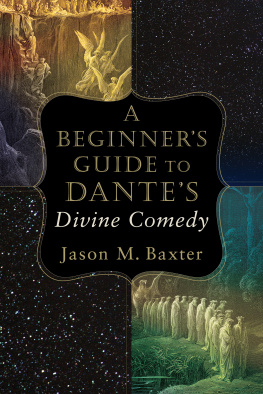Almost every thought, almost every sentence in what follows was born in conversation with my wife, my teachers, my friends, or my students. I read each one of the chapters below to little groups of students or friends in my home, over wine and cheese and bread, and the remarks made in the conversations that followed found their way into this book. For this reason I am deeply grateful to my present and past students (who are now my friends), especially Cody Lee, Trevor Lontine, Claire DAgostino, Hannah Gleason, Jacob Terneus, Joe and Rachel Turner, Scott Sargeant, Isaac Owen, and my fellow dantista Carolyn De Salvo. I am grateful to my South Bend friends (Kirk, Maggie, Steve, and Sue) who were my very first audience, anesthetized by Rioja. Heartfelt gratitude goes out to my advisors and professors at Notre Dame, especially Ted Cachey, Christian Moeves, Zyg Baranski, Stephen Gersh, Ann Astell, and especially Vittorio Montemaggi, who more than anyone else taught me what it means to study Dante. My friend Colum Dever invited me to Duke, where I gave two lectures that serve as the basis for two of the chapters below. Another friend from Notre Dame, Tommy Clemmons, was the inspiration to ask Baker Academic if they would publish this book. Over a beautiful summer in Ischia and in the Pincio of the Villa Borghese, my friends James and Judiann listened to revision after revision and provided me with poignant suggestions for improvement. I would like to thank my parents, Bob and Pauletta, and my brother, Josh, for their support, which goes deeper than I can identify. And, finally, to my best friend, my most challenging interlocutor, most fastidious editor, and source of encouragement and inspiration, Jodi. We made it. This book is dedicated to you.
3
The Graveyard of the Heretics and the Wasteland of the Violent
( Inferno 1017)
New Beginnings and Infernal Architecture ( Inferno 911)
Inferno 9 ends with Dante and Virgil walking into the conquered fortress. Now they can see what precious thing the devils were so jealously guarding. We are rather surprised to discover what it is: an eerie graveyard in which all the lids of the big stone sarcophagi are off and standing to the side. The pilgrim can see a flame gleaming in each tomb, burning from below. This is the pathetic treasure hoarded by the demons. The souls in heaven will be described as precious gems (see, for example, Par. 18.11517); but the wealth of hell is the dead, gaunt, self-absorbed souls of those punished within.
Passing through the Gate of Dis is a major transition, signaling that Dante and Virgil have entered the antechamber of what we could call deep hell. Fascinatingly, this is a threshold that Aeneas was not allowed to cross:
Aeneas suddenly looked back, and, below the left hand cliff,
he saw wide battlements, surrounded by a triple wall....
A gate fronts it, vast, with pillars of solid steel,
that no human force, not the heavenly gods themselves,
can overturn by war: an iron tower rises into the air....
Groans came from there, and the cruel sound of the lash,
then the clank of iron, and dragging chains....
Then the prophetess began to speak as follows: Famous leader
of the Trojans, it is forbidden for the pure to cross the evil threshold:
... all of them dared monstrous sin, and did what they dared.
Not if I had a hundred tongues, a hundred mouths,
a voice of iron, could I tell all the forms of wickedness
or spell out the names of every torment. ( Aen. 6.535627)
Clearly, Dantes own Dis has been inspired by Virgils, but his pilgrim will go where even the great Aeneas was not allowed to explore. Meanwhile, the poet dares to speak about things the classical poets avoided. Seven hundred years before Virgil, the archaic Greek poet Hesiod said that deep hell, Tartarus, is a place that is fearful even to the gods. It was radically off-limits. But Dante the pilgrim will enter. He will see what lies at the bottom of the human heart. For the Christian, real purity cannot be achieved unless the heart is explored down to its base. The monsters, like Medusa, have to be called forth and made to emerge. Thus, in the next twenty-five canti Dante will be exploring new ground, ground that neither Aeneas the hero nor Virgil the poet had previously trod.
Shortly after the travelers pass through the Gate of Dis, the poet (in Inf. 11) will take the opportunity to help organize the many bewildering things his pilgrim has experienced and will experience. In the first third of Inferno , the pilgrim has had a number of intense face-to-face encounters with sinners, but he doesnt seem to have been aware of how orderly hell actually is. Now his master informs him that hell is divided into two major divisions, separated by the walls of Dis: (1) upper hell, whose circles we have read about, where the incontinent sins are punished ( Inf. 38); and (2) lower hell, which is surrounded by the grimy iron walls of Dis. It is within the walls of Dis, or within lower hell, that the sins of malice are punished. Dante, who is loosely cobbling together all kinds of classical theories about vice, thinks that the deep principle that divides the sins of upper hell (the incontinent) from the sins of lower hell (the violent, fraudulent, and traitorous) is malice. In the end, the sinners of deep hell want the same things the sinners of upper hell want, even if they act like they are more sophisticated. The truth is that they too are greedy, wrathful, gluttonous, and lustful. The difference is that they are willing to hurt fellow human beings (or themselves) to get what they want.











